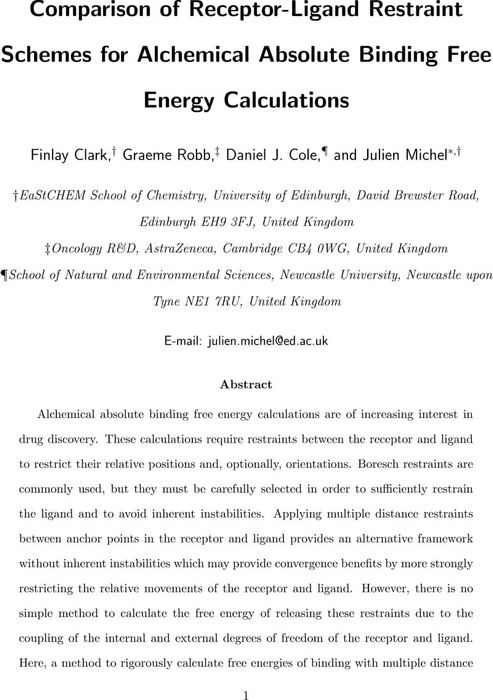Abstract
Alchemical absolute binding free energy calculations are of increasing interest in drug discovery. These calculations require restraints between the receptor and ligand to restrict their relative positions and, optionally, orientations. Boresch restraints are commonly used, but they must be carefully selected in order to sufficiently restrain the ligand and to avoid inherent instabilities. Applying multiple distance restraints between anchor points in the receptor and ligand provides an alternative framework without inherent instabilities which may provide convergence benefits by more strongly restricting the relative movements of the receptor and ligand. However, there is no simple method to calculate the free energy of releasing these restraints due to the coupling of the internal and external degrees of freedom of the receptor and ligand. Here, a method to rigorously calculate free energies of binding with multiple distance restraints by imposing intramolecular restraints on the anchor points is proposed. Ab- solute binding free energies for the human macrophage migration inhibitory factor - MIF180 system obtained using a variety of Boresch restraints and rigorous and non- rigorous implementations of multiple distance restraints are compared. It is shown that several multiple distance restraints schemes produce estimates in good agreement with Boresch restraints. In contrast, calculations without orientational restraints produce erroneously favourable free energies of binding by up to approximately 4 kcal mol−1. These approaches offer new options for the deployment of alchemical absolute binding free energy calculations.
Content

Supplementary materials

Supporting Information
SI for the manuscript
Supplementary weblinks
Software associated with the manuscript
Instructions, code and sample inputs to reproduce the finding of this study.


![Author ORCID: We display the ORCID iD icon alongside authors names on our website to acknowledge that the ORCiD has been authenticated when entered by the user. To view the users ORCiD record click the icon. [opens in a new tab]](https://chemrxiv.org/engage/assets/public/chemrxiv/images/logos/orcid.png)

